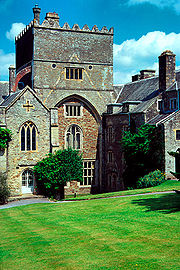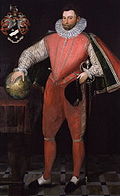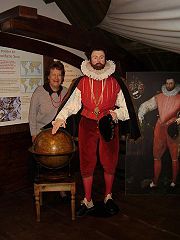
Buckland Abbey
Encyclopedia

Buckland Monachorum
Buckland Monachorum is a village and civil parish in the West Devon district of Devon, England, situated on the River Tavy, about 10 miles north of Plymouth.In 2006 the neighbourhood had an estimated 1,511 residents and 654 dwellings....
, near Yelverton
Yelverton, Devon
Yelverton is a large village on the south-western edge of Dartmoor, Devon, in England.When the village's railway station opened in the 19th century, the village became a popular residence for Plymouth commuters...
, Devon
Devon
Devon is a large county in southwestern England. The county is sometimes referred to as Devonshire, although the term is rarely used inside the county itself as the county has never been officially "shired", it often indicates a traditional or historical context.The county shares borders with...
, England
England
England is a country that is part of the United Kingdom. It shares land borders with Scotland to the north and Wales to the west; the Irish Sea is to the north west, the Celtic Sea to the south west, with the North Sea to the east and the English Channel to the south separating it from continental...
, noted for its connection with Sir Francis Drake
Francis Drake
Sir Francis Drake, Vice Admiral was an English sea captain, privateer, navigator, slaver, and politician of the Elizabethan era. Elizabeth I of England awarded Drake a knighthood in 1581. He was second-in-command of the English fleet against the Spanish Armada in 1588. He also carried out the...
and presently in the ownership of the National Trust
National Trust for Places of Historic Interest or Natural Beauty
The National Trust for Places of Historic Interest or Natural Beauty, usually known as the National Trust, is a conservation organisation in England, Wales and Northern Ireland...
.
History
Buckland was originally a Cistercian abbeyAbbey
An abbey is a Catholic monastery or convent, under the authority of an Abbot or an Abbess, who serves as the spiritual father or mother of the community.The term can also refer to an establishment which has long ceased to function as an abbey,...
founded in 1278 by Amicia, Countess of Devon and was a daughter house of Quarr Abbey
Quarr Abbey
Quarr Abbey is a monastery between the villages of Binstead and Fishbourne on the Isle of Wight in southern England. The name is pronounced as "Kor" . It belongs to the Order of St Benedict. The present imposing brick construction was completed in 1912. A community of about a dozen monks maintains...
, on the Isle of Wight
Isle of Wight
The Isle of Wight is a county and the largest island of England, located in the English Channel, on average about 2–4 miles off the south coast of the county of Hampshire, separated from the mainland by a strait called the Solent...
. It remained an abbey until the Dissolution of the Monasteries
Dissolution of the Monasteries
The Dissolution of the Monasteries, sometimes referred to as the Suppression of the Monasteries, was the set of administrative and legal processes between 1536 and 1541 by which Henry VIII disbanded monasteries, priories, convents and friaries in England, Wales and Ireland; appropriated their...
by King Henry VIII
Henry VIII of England
Henry VIII was King of England from 21 April 1509 until his death. He was Lord, and later King, of Ireland, as well as continuing the nominal claim by the English monarchs to the Kingdom of France...
. In 1541 Henry sold Buckland to Sir Richard Grenville who, working with his son Roger, began to convert the abbey into a residence. Roger died in 1545, leaving a son, also named Richard Grenville
Richard Grenville
Sir Richard Grenville was an English sailor, sea captain and explorer. He took part in the early English attempts to settle the New World, and also participated in the fight against the Spanish Armada...
, who completed the conversion. He eventually sold Buckland to Drake in 1581. The abbey is unusual in that the church was retained as the principal component of the new house whilst most of the remainder was demolished, which was a reversal of the normal outcome with this type of redevelopment.
Drake lived in the house for 15 years, as did many of his collateral descendants until 1946, when it was sold to a local landowner, Arthur Rodd, who presented the property to the National Trust in 1948.
Buckland today
The property has been open to the public since 1951. The National Trust operates it with the assistance of the city of PlymouthPlymouth
Plymouth is a city and unitary authority area on the coast of Devon, England, about south-west of London. It is built between the mouths of the rivers Plym to the east and Tamar to the west, where they join Plymouth Sound...
— the City of Plymouth Museums and Art Museum use the building to house part of their collection.
The collection is noted for the presence of "Drake's Drum
Drake's Drum
Drake’s Drum is a snare drum that Sir Francis Drake took with him when he circumnavigated the world. Shortly before he died he ordered the drum to be taken to Buckland Abbey, where it still is today, and vowed that if England was ever in danger someone was to beat the drum and he would return to...
". A number of independent craft workshops are located in the converted ox sheds.
Costume Group



